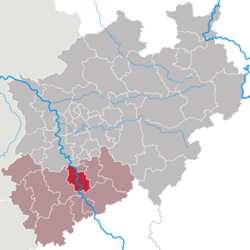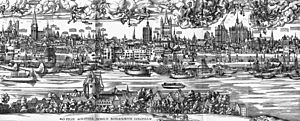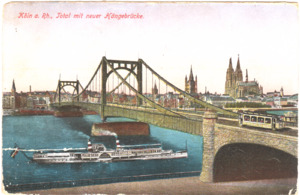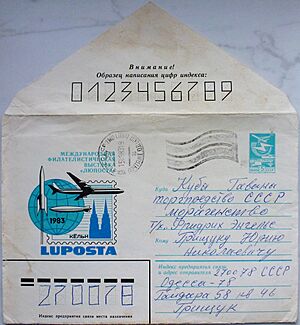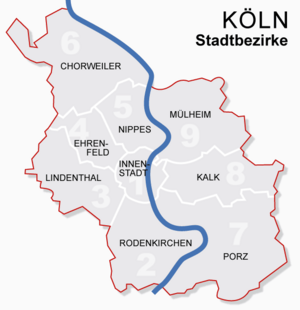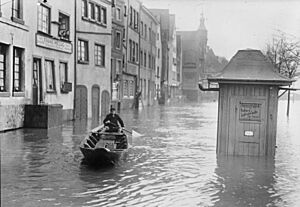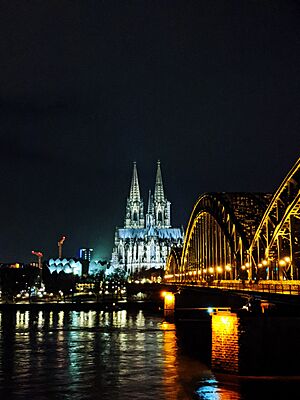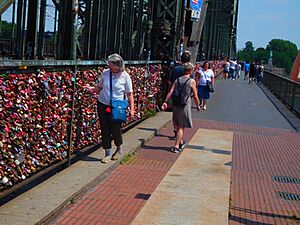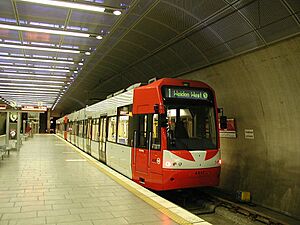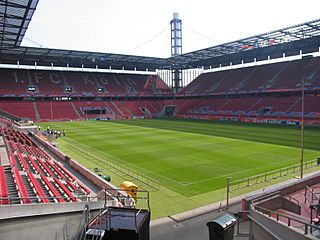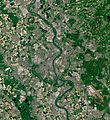Cologne facts for kids
Quick facts for kids
Cologne
|
|||
|---|---|---|---|
|
View of Cologne with the Kranhäuser, Cologne Cathedral, Great St. Martin Church and the Rhine
Cologne Cathedral and Hohenzollern Bridge
Decagon of St Gereon's Basilica
Flora Botanical Garden
Basilica of St. Cunibert
|
|||
|
|||
| Lua error in Module:Location_map at line 530: Unable to find the specified location map definition: "Module:Location map/data/Germany Nordrhein-Westfalen" does not exist. | |||
| Country | Germany | ||
| State | North Rhine-Westphalia | ||
| Admin. region | Cologne | ||
| District | Urban district | ||
| Founded | 38 BCE | ||
| Area | |||
| • City | 405.15 km2 (156.43 sq mi) | ||
| Elevation | 37 m (121 ft) | ||
| Population
(2022-12-31)
|
|||
| • City | 1,084,831 | ||
| • Density | 2,677.60/km2 (6,934.96/sq mi) | ||
| • Urban | 3,500,000 (Cologne Bonn) | ||
| • Metro | 8,711,712 (Rhineland) | ||
| Time zone | UTC+01:00 (CET) | ||
| • Summer (DST) | UTC+02:00 (CEST) | ||
| Postal codes |
50441–51149
|
||
| Dialling codes | 0221, 02203 (Porz) | ||
| Vehicle registration | K | ||
Cologne (pronounced kə-LOHN) is a big city in Germany. It's the largest city in the state of North Rhine-Westphalia. It's also the fourth-biggest city in all of Germany. About 1.1 million people live in Cologne itself. If you count the areas around it, over 3.1 million people call the Cologne Bonn Region home. Cologne is located on the Rhine River. It's about 35 kilometers (22 miles) southeast of Düsseldorf.
One of Cologne's most famous buildings is the Cologne Cathedral. This huge Gothic church was once the tallest building in the world. It was built to hold special relics, like those of the Three Wise Men. Today, it's a very popular place to visit in Europe. The city is also known for Eau de Cologne, a famous perfume made there since 1709.
Cologne has a long history. It was founded by the Romans in the 1st century CE. Its name comes from the Roman word "Colonia." In the Middle Ages, Cologne became a very important city for trade. It was part of the Hanseatic League, a group of trading cities. It was one of the biggest cities in Europe during that time.
Before World War II, Cologne was occupied by the French and British. It became part of Prussia in 1815. During World War II, Cologne was heavily bombed. About 80% of the old city center was destroyed. After the war, the city was rebuilt. Many historic buildings, like churches and city gates, were carefully restored. Today, about a quarter of Cologne's buildings were built before World War II. The city has around 9,000 historic buildings.
Cologne is a major center for culture in the Rhineland. It has more than 30 museums and many art galleries. It's also home to several important universities. These include the University of Cologne, one of Europe's oldest and largest universities. Cologne is a big research hub, especially for the aerospace industry. Large companies like Lufthansa (Europe's biggest airline) and Ford of Europe have their main offices here. The Cologne Trade Fair hosts many big events.
Contents
- Cologne's History: A Journey Through Time
- Cologne's Location and Layout
- People of Cologne: A Diverse Community
- Cologne's Look and Feel
- Visiting Cologne: Top Sights
- Cologne's Culture and Fun
- Cologne's Economy: A Hub of Business
- Getting Around Cologne: Transport Options
- Learning in Cologne: Universities and Research
- Cologne in the Media
- Sports in Cologne
- Famous People from Cologne
- Cologne's Sister Cities
- Images for kids
- See also
Cologne's History: A Journey Through Time
Ancient Roman Cologne: How it Started
The first settlement in Cologne was called Oppidum Ubiorum. It was founded in 38 BCE by a Germanic tribe called the Ubii. In 50 CE, the Romans built a city there called Colonia Claudia Ara Agrippinensium. This city became the capital of the Roman province of Germania Inferior in 85 CE. You can still find many Roman remains in Cologne today. For example, a 1,900-year-old Roman boat was found in 2007.
From 260 to 271 CE, Cologne was the capital of the Gallic Empire. This was a separate empire that broke away from the main Roman Empire for a short time. In 310 CE, a bridge was built over the Rhine River. Cologne became a very important trade and production center in the Roman Empire.
The first known bishop of Cologne, Maternus, was elected in 313 CE. The city was a Roman provincial capital until 462 CE. That's when the Ripuarian Franks took control. Parts of the old Roman sewers are still under the city.
There's also evidence of a Jewish community in Cologne from ancient times. In 321 CE, Emperor Constantine allowed a Jewish community to settle there. They had all the freedoms of Roman citizens. This is the oldest written proof of a Jewish community in Germany.
Cologne in the Middle Ages: A Powerful City
In the early Middle Ages, Cologne was part of the Frankish Empire. It had been a bishop's seat since Roman times. In 795, the bishop of Cologne became an archbishop. This made him a very important religious leader.
In 953, the archbishops of Cologne gained a lot of power. They became like secular princes. This created the Electorate of Cologne. By the end of the 12th century, the Archbishop of Cologne was one of the seven electors who chose the Holy Roman Emperor.
After a big battle in 1288, Cologne became a Free Imperial City. This meant it was independent from the archbishops. The city council was in charge of most things.
Cologne also became a major place for pilgrimages. In 1164, the relics of the Three Wise Men were brought to Cologne Cathedral. This made the city even more famous.
Cologne's location on the Rhine River was perfect for trade. It was at the crossroads of major trade routes across Europe. By the late 12th century, the city was surrounded by walls. By 1300, about 50,000 to 55,000 people lived there. Cologne joined the Hanseatic League, a powerful trade group. Its system of weights and measurements was even used across Europe!
Early Modern Cologne: A Free City
Cologne's economy in the Middle Ages and early modern times was based on its busy harbor and trade. Skilled workers were organized into guilds.
As a free imperial city, Cologne was like its own small state within the Holy Roman Empire. It had its own army, known as the Rote Funken (red sparks). These soldiers wore red uniforms. Today, a famous carnival group in Cologne keeps the tradition of the Rote Funken alive.
It's important not to confuse the Free Imperial City of Cologne with the Electorate of Cologne. The Electorate was a separate state ruled by the archbishops. Because Cologne was a free city, the archbishops usually couldn't live inside it. They lived in nearby Bonn or Brühl.
From the 19th Century to World War I
Cologne lost its status as a free city during the French rule. In 1801, it became part of the French Republic. The French brought new laws, like the Napoleonic code. This code stayed in use until 1900. In 1815, Cologne became part of the Kingdom of Prussia.
There were often disagreements between the Catholic people of the Rhineland and the mostly Protestant Prussian government. These conflicts made many Catholics feel distant from Berlin.
During the 19th and 20th centuries, Cologne grew a lot. It took in many smaller towns. By World War I, it had 700,000 residents. Factories and industries helped the city grow. Vehicle and engine making became very important.
The Cologne Cathedral, which was started in 1248 but stopped being built around 1560, was finally finished in 1880. It became a symbol of the new German Empire. Some of the city's old buildings were torn down to make way for new ones during this growth.
Cologne was also a heavily fortified city. It had two rings of forts and defensive walls. This made it hard for the city to expand.
During World War I, Cologne had some small air raids but wasn't badly damaged. After the war, the British Army occupied Cologne until 1926. The British were generally fair to the local people. Konrad Adenauer, who was mayor of Cologne and later Germany's first chancellor, saw how important this was.
As part of peace agreements, Cologne's fortifications had to be removed. This was a chance to create two large public parks, called Grüngürtel (green belts), around the city. The University of Cologne, which had been closed, reopened in 1919. Cologne did well during the Weimar Republic (1919–33). It made progress in city planning and housing. Cologne even tried to host the Olympics. Its airport became a busy hub for air travel.
In 1933, the Nazi Party gained power in Cologne. They arrested members of other political parties. Mayor Adenauer was removed from his job. However, the Nazis never had as much support in Cologne as in some other big cities. By 1939, the population was 772,221.
World War II and Rebuilding Cologne
During World War II, Cologne was a military command center. The Allies dropped a huge amount of bombs on the city. About 61% of Cologne's buildings were destroyed. The city had 262 air raids. Around 20,000 civilians lost their lives. The central part of the city was almost completely wiped out.
On May 31, 1942, Cologne was the target of "Operation Millennium". This was the first time 1,000 bombers attacked a city in World War II. This raid lasted about 75 minutes. It destroyed a large area and left 59,000 people without homes.
American forces took Cologne in March 1945. By the end of the war, 95% of Cologne's population had left the city. This was mostly due to people moving to safer, rural areas. By the end of 1945, about 450,000 people had returned. Sadly, almost all of Cologne's Jewish population (11,000 people) were killed or deported by the Nazis. The city's synagogues were destroyed. One synagogue was rebuilt in 1959.
Cologne After the War: A New Start
Even though Cologne was the biggest city in the region, Düsseldorf was chosen as the capital of North Rhine-Westphalia. Bonn became the temporary capital of West Germany. Cologne benefited from being between these two important cities. Many federal agencies and organizations are still located in Cologne.
In 1947, a plan was made to rebuild Cologne. This plan included new main roads through the city center. It was easier to build these roads because much of the city was in ruins.
The destruction of 95% of the city center, including many historic churches, was a huge loss. But many people wanted to rebuild these landmarks. The reconstruction continued until the 1990s.
By 1959, Cologne's population was back to its pre-war numbers. It grew steadily and reached over 1 million people again in 2010.
Cologne Today: A Modern City
In the 1980s and 1990s, Cologne's economy grew. This was partly because many media companies moved there. The city also improved its transportation. This made Cologne easy to reach in Central Europe.
The Cologne Trade Fair expanded in 2005. The old buildings were rented to Mediengruppe RTL Deutschland, a large private broadcaster.
Cologne's Location and Layout
City Districts: How Cologne is Organized
Cologne covers over 405 square kilometers (156 square miles). The highest point in the city is the Monte Troodelöh, at 118 meters (387 feet) above sea level. The lowest point is 37.5 meters (123 feet) above sea level. Cologne is located in the Cologne Lowland, a flat area of the central Rhineland.
Cologne is divided into 9 boroughs, called Stadtbezirke. These boroughs are then split into 85 smaller districts, called Stadtteile.
Cologne's Weather: A Mild Climate
Cologne has a mild, oceanic climate. This means it has cool winters and warm summers. It's one of the warmest cities in Germany. But it's also one of the cloudiest. The average temperature for the year is about 10.7°C (51.3°F). In January, it's around 3.0°C (37.4°F), and in July, it's about 19.0°C (66.2°F). The highest temperature ever recorded was 40.3°C (104.5°F) in July 2019. Rain is spread out throughout the year, with a bit more in summer due to thunderstorms.
Protecting Cologne from Floods
Cologne often experiences floods from the Rhine River. It's known as the most flood-prone city in Europe. A special city agency manages a system to control floods. This system includes walls, monitoring, and pumping stations. It was improved after a big flood in 1993.
People of Cologne: A Diverse Community
Cologne is the fourth-largest city in Germany by population. As of 2021, over 1 million people live in Cologne. The city is quite dense, with about 2,700 people per square kilometer (7,000 per square mile). Cologne first reached 1 million people in 1975, and again in 2009.
The Cologne Bonn Region has over 3.5 million people. It's part of the larger Rhine-Ruhr area, which has over 11 million people.
In 2021, there were more women (551,528) than men (527,773) in Cologne. About 16.3% of the population was under 18. And 17.8% were 65 or older.
Many people in Cologne have a family background from other countries. About 40.5% of the population has a migrant background. In 2021, 2,254 people became German citizens. Most households in Cologne are single-person households (51%).
Turkish Community in Cologne
Cologne has a large Turkish community, with about 90,000 people of Turkish origin. It's the second-largest Turkish population in a German city, after Berlin. There's a "Little Istanbul" area in Keupstraße with many Turkish restaurants and markets.
Languages Spoken in Cologne
The local dialect in Cologne is called Colognian or Kölsch. It's a special dialect spoken in the area around Cologne. Kölsch is one of the few city dialects in Germany. There's a popular joke that Kölsch is the only language you can drink, because it's also the name of the local beer!
Religions in Cologne
Many people in Cologne belong to the Catholic Church (35.5% in 2015). About 15.5% are Protestant. Christianity came to Cologne very early, possibly with Roman soldiers. Cologne is the seat of the Archdiocese of Cologne.
There are also several mosques in Cologne, including the Cologne Central Mosque. In 2011, about 11.2% of the population was Muslim.
Cologne has one of the oldest and largest Jewish communities in Germany. In 2011, 0.3% of Cologne's population was Jewish.
In 2021, the Mayor of Cologne announced that all 35 mosques in the city could broadcast the Adhan (prayer call) on Fridays. This shows how much Cologne values its diverse community.
Cologne's Look and Feel
Much of Cologne's inner city was destroyed during World War II. When it was rebuilt, it followed the style of the 1950s. But it kept the old street layout. So, today, the city center has a lot of modern buildings. Some older buildings were rebuilt because they were historically important. About 25% of Cologne was built before 1945.
Green areas make up over a quarter of Cologne. This means there's about 75 square meters (807 square feet) of public green space for every person!
Wildlife in the City
You'll see many insects, small rodents, and birds in Cologne. Pigeons are very common. But there's also a growing number of exotic birds, like rose-ringed parakeets. These green parrots stand out against the city's buildings.
Hedgehogs, rabbits, and squirrels live in the parks. In the outer parts of the city, you might even spot foxes and wild boar.
Visiting Cologne: Top Sights
Cologne is a popular place for tourists. In 2016, it had 5.8 million overnight stays.
Famous Churches
- Cologne Cathedral (Kölner Dom) is the most famous building in Cologne. It's a huge Gothic church that was started in 1248 and finished in 1880. It's a World Heritage Site and holds the Shrine of the Three Kings. People in Cologne sometimes call it "the eternal construction site" because it took so long to build!
- Twelve Romanesque churches: These are amazing examples of medieval church architecture. Some of them date back to Roman times. Most were badly damaged in World War II but have been rebuilt.
Historic Buildings
The Cologne City Hall (Kölner Rathaus) was founded in the 12th century. It's the oldest city hall in Germany that's still in use. Other famous old buildings include the Gürzenich and the Overstolzenhaus.
Medieval City Gates
Cologne once had twelve medieval city gates. Today, only three are still standing: the Eigelsteintorburg, the Hahnentor, and the Severinstorburg.
Shopping Streets
- The Cologne Ring boulevards are known for their nightlife. They also feature medieval city gates.
- Hohe Straße is a main shopping area near the cathedral. It has many gift shops, clothing stores, and restaurants.
- Schildergasse is another very busy shopping street. A study in 2008 said it was the busiest in Europe!
- Ehrenstraße is a more unique and stylish shopping area.
Bridges Over the Rhine
Several bridges cross the Rhine River in Cologne. The Hohenzollern Bridge is a famous railway bridge. You can also cross the river using the Cologne Cable Car. This cableway goes between the Cologne Zoological Garden and the Rheinpark.
Tall Buildings in Cologne
Cologne's tallest structure is the Colonius telecommunication tower, which is 266 meters (873 feet) tall. Its observation deck has been closed since 1992. Other tall buildings include the KölnTurm and the Colonia-Hochhaus.
| Skyscraper | Image | Height in meters | Floors | Year | Address | Notes |
|---|---|---|---|---|---|---|
| KölnTurm |  |
148.5 | 43 | 2001 | MediaPark 8, Neustadt-Nord | (literally: Cologne Tower), Cologne's second tallest building. The 30th floor has a restaurant and a terrace with 360° views of the city. |
| Colonia-Hochhaus |  |
147 | 45 | 1973 | An der Schanz 2, Riehl | Was the tallest building in Germany from 1973 to 1976. Today, it's still the country's second tallest residential building. |
| Rheintower |  |
138 | 34 | 1980 | Raderberggürtel, Marienburg | Former headquarters of Deutsche Welle. |
| Uni-Center |  |
133 | 45 | 1973 | Luxemburger Straße, Sülz | |
| TÜV Rheinland |  |
112 | 22 | 1974 | Am Grauen Stein, Poll | |
| Ringturm |  |
109 | 26 | 1973 | Ebertplatz, Neustadt-Nord | |
| Justizzentrum Köln |  |
105 | 25 | 1981 | Luxemburger Straße, Sülz | |
| KölnTriangle |  |
103 | 29 | 2006 | Ottoplatz 1, Deutz | Across from the cathedral, with a 103-meter (338-foot) high viewing platform. |
| Herkules-Hochhaus |  |
102 | 31 | 1969 | Graeffstraße 1, Ehrenfeld | |
| Deutschlandfunk-Turm |  |
102 | 19 | 1975 | Raderberggürtel, Marienburg |
Cologne's Culture and Fun
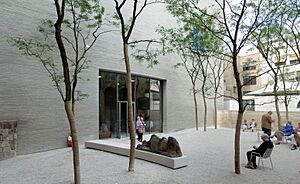
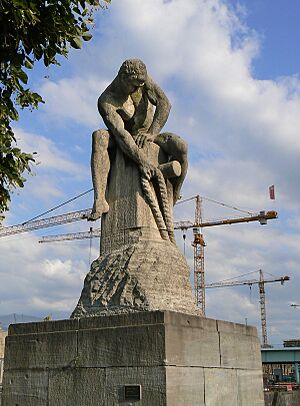
Cologne has many museums. The Roman-Germanic Museum shows art from the city's ancient past. The Museum Ludwig has a huge collection of modern art, including many Picasso paintings. The Museum Schnütgen shows religious art. Many art galleries in Cologne are famous worldwide.
Cologne has over 60 music venues. It's a big center for electronic music. The public radio station WDR helped make Krautrock popular in the 1970s. The band Can was formed here in 1968. Cologne also has many places for nightlife, especially in the student quarter.
Cologne hosts a large yearly literary festival called lit.COLOGNE. The famous writer Heinrich Böll, who won the Nobel Prize, is connected to Cologne. There's also an annual philosophy festival.
Cologne is known for its beer, called Kölsch. As mentioned, the local dialect is also called Kölsch. This leads to the joke that Kölsch is the only language you can drink!
Cologne is also famous for Eau de Cologne (meaning "Water of Cologne"). This perfume was created in the early 18th century by Johann Maria Farina. It became very popular across Europe. Today, the original Eau de Cologne is still made in Cologne by the Farina family. Another famous brand, 4711, also makes cologne in the city.
Cologne Carnival: A Huge Party!
The Cologne carnival is one of Europe's biggest street festivals. The carnival season officially begins on November 11th at 11:11 a.m. It lasts until Ash Wednesday. But the "crazy days" (Tolle Tage) start on the Thursday before Ash Wednesday. This is when the street carnival begins. Streets and bars are filled with people in costumes dancing. Hundreds of thousands of visitors come to Cologne for this time. About a million people celebrate in the streets on that Thursday.
Cologne vs. Düsseldorf: A Friendly Rivalry
Cologne and Düsseldorf have a "fierce regional rivalry." This includes carnival parades, ice hockey, football, and especially beer! People in Cologne prefer Kölsch beer. People in Düsseldorf prefer Altbier. Waiters in each city might joke if you order the "wrong" beer! This rivalry is often called a "love–hate relationship." The Kölsch beer style is special because only breweries in Cologne are allowed to use the name "Kölsch."
Cologne's Museums: Explore and Learn

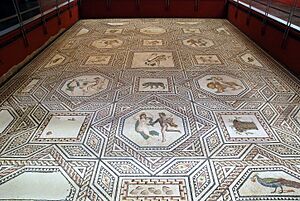
- Farina Fragrance Museum – where Eau de Cologne was invented.
- Römisch-Germanisches Museum – learn about ancient Roman and Germanic culture.
- Wallraf-Richartz Museum – European paintings from the 13th to the early 20th century.
- Museum Ludwig – a great collection of modern art.
- Museum Schnütgen – medieval art.
- Museum für Angewandte Kunst – applied art (art used in everyday objects).
- Kolumba Kunstmuseum des Erzbistums Köln – a modern art museum built around medieval ruins.
- Cathedral Treasury "Domschatzkammer" – historic underground vaults of the Cathedral.
- EL-DE Haus – a museum about the Nazi rule in Cologne.
- German Sports and Olympic Museum – exhibitions about sports history.
- Imhoff-Schokoladenmuseum – the Chocolate Museum!
- Geomuseum of the University of Cologne – features fossils, stones, and minerals.
- Flora und Botanischer Garten Köln – the city's main botanical garden.
Music Events and Festivals
Cologne used to host the famous Ringfest. Now it has the C/o pop festival.
The city also has several wonderful Christmas Markets (Weihnachtsmarkt).
Cologne's Economy: A Hub of Business

Cologne is a major economic center in the Rhine-Ruhr metropolitan region. Its economy focuses on insurance and media industries. It's also a big cultural and research center. Many company headquarters are located here.
Some of the largest media companies in Cologne include Westdeutscher Rundfunk, RTL Television, and n-tv. Many TV production studios and art agencies are also here. Big insurance companies like Axa and Zurich Financial Services have offices in Cologne.
The German airline Lufthansa has its main headquarters in Cologne. Ford of Europe has its European headquarters and a factory in Niehl. Toyota Motorsport GmbH, Toyota's official motorsports team, is also based in Cologne. Other large companies include the REWE Group and TÜV Rheinland.
Cologne is famous for its Kölsch breweries. The three largest are Reissdorf, Gaffel, and Früh.
| Brewery | Established | Annual output in hectoliters |
|---|---|---|
| Heinrich Reissdorf | 1894 | 650,000 |
| Gaffel Becker & Co | 1908 | 500,000 |
| Cölner Hofbräu Früh | 1904 | 440,000 |
Cologne has always been an important trading city. It has five ports on the Rhine River. These make it the second-largest inland port in Germany. Cologne Bonn Airport is the second-largest freight terminal in Germany. The Cologne trade fair is a major European location for trade shows.
Cologne has seen a big increase in new startup companies, especially in digital businesses.
Cologne was also the first German city with over a million people to declare a climate emergency.
Getting Around Cologne: Transport Options
Roads and Cycling
Cologne was a leader in road building in the 1920s. The first German limited-access road was built between Cologne and Bonn in 1929. Today, Cologne was the first German city to have a full motorway ring road around it.
Compared to other German cities, Cologne is not very bicycle-friendly. It has often ranked low in bike-friendliness surveys.
Trains and Public Transport
Cologne has excellent train services. High-speed trains like ICE and Thalys connect Cologne to cities like Amsterdam, Brussels, Paris, Frankfurt, and Berlin.
The Cologne Stadtbahn is a large light rail system. It runs partly underground and connects Cologne with nearby cities. It grew from the old tram system. Düsseldorf is also linked by S-Bahn trains. The Rhine-Ruhr S-Bahn has 5 lines that cross Cologne. One line runs 24/7 between Cologne Main Station and Cologne/Bonn Airport.
Buses and Water Transport
There are many buses that cover most of the city and its suburbs. You can also take Eurolines coaches to other countries.
Häfen und Güterverkehr Köln (HGK) manages Cologne's ports on the Rhine. These are some of the largest inland ports in Europe.
Cologne's Airport
Cologne's international airport is Cologne Bonn Airport (CGN). It's also called Konrad Adenauer Airport, named after Germany's first post-war Chancellor. The airport is shared with the city of Bonn. Cologne is also home to the headquarters of the European Aviation Safety Agency (EASA).
Learning in Cologne: Universities and Research
Cologne is home to many universities and colleges, with about 72,000 students. The University of Cologne (founded in 1388) is the largest university in Germany. The Cologne University of Applied Sciences is the largest university of applied sciences in the country. The Cologne University of Music and Dance is Europe's largest music school.
|
|
The Lauder Morijah School, a Jewish school, reopened in 2002 after more Jewish people moved to Cologne.
Cologne in the Media
Cologne is a very important media center in Germany. Many radio and television stations, like Westdeutscher Rundfunk (WDR), RTL, and VOX, have their main offices here. Film and TV production are also big industries. A third of all German TV shows are made in the Cologne region. The city also hosts the Cologne Comedy Festival, which is the largest comedy festival in mainland Europe.
Sports in Cologne
Cologne is home to the football club 1. FC Köln. They play in the 2. Bundesliga (second division). Their home stadium is RheinEnergieStadion, which hosted five matches during the 2006 FIFA World Cup. This stadium has won awards for being one of the best sports venues in the world. Other football clubs in Cologne include FC Viktoria Köln and SC Fortuna Köln.
Cologne also has an ice hockey team called Kölner Haie. They play in Germany's top ice hockey league at the Lanxess Arena.
Horse races have been held at the Cologne-Weidenpesch Racecourse since 1897. The annual Cologne Marathon started in 1997. The classic cycling race Rund um Köln has been held since 1908. Cologne also has a long history in rowing.
Toyota Motorsport GmbH, Toyota's main motorsports facility, is in Cologne. They work on Toyota's racing cars for major championships.
Cologne is sometimes called "the secret golf capital of Germany." It has many golf options and hosts top events.
The city has hosted many athletic events, including the 2005 FIFA Confederations Cup, the 2006 FIFA World Cup, and the Ice Hockey World Championships in 2010 and 2017. It will also host matches for the 2024 FIFA European Championship. Since 2014, Cologne has hosted ESL One Cologne, a big CS GO tournament.
Cologne is also home to Germany's oldest boxing club, the SC Colonia 06, and the world's oldest active weightlifting club, the Kölner Athleten-Club 1882.
Famous People from Cologne
- Leon Draisaitl, ice hockey player
- Kim Petras, Grammy award-winning singer-songwriter
- Paul-Jürgen Weber, visual artist and photographer
Cologne's Sister Cities
Cologne is connected with many cities around the world. These are called sister cities.
 Barcelona, Spain (1984)
Barcelona, Spain (1984) Beijing, China (1987)
Beijing, China (1987) Bethlehem, Palestine (1996)
Bethlehem, Palestine (1996) Cluj-Napoca, Romania (1976)
Cluj-Napoca, Romania (1976) Corinto, Nicaragua (1988)
Corinto, Nicaragua (1988) Cork, Ireland (1988)
Cork, Ireland (1988) Esch-sur-Alzette, Luxembourg (1958)
Esch-sur-Alzette, Luxembourg (1958) Indianapolis, United States (1988)
Indianapolis, United States (1988) Istanbul, Turkey (1997)
Istanbul, Turkey (1997) Katowice, Poland (1991)
Katowice, Poland (1991) Kyoto, Japan (1963)
Kyoto, Japan (1963) Liège, Belgium (1958)
Liège, Belgium (1958) Lille, France (1958)
Lille, France (1958) Liverpool, England, United Kingdom (1952)
Liverpool, England, United Kingdom (1952) Neukölln (Berlin), Germany (1967)
Neukölln (Berlin), Germany (1967) El Realejo, Nicaragua (1988)
El Realejo, Nicaragua (1988) Rio de Janeiro, Brazil (2011)
Rio de Janeiro, Brazil (2011) Rotterdam, Netherlands (1958)
Rotterdam, Netherlands (1958) Tel Aviv, Israel (1979)
Tel Aviv, Israel (1979) Thessaloniki, Greece (1988)
Thessaloniki, Greece (1988) Treptow-Köpenick (Berlin), Germany (1990)
Treptow-Köpenick (Berlin), Germany (1990) Tunis, Tunisia (1964)
Tunis, Tunisia (1964) Turin, Italy (1958)
Turin, Italy (1958) Turku, Finland (1967)
Turku, Finland (1967)
Cologne also works with:
 Dnipro, Ukraine (2022)
Dnipro, Ukraine (2022)
Former Sister Cities
 Volgograd, Russia (1988) - this partnership was paused in 2022.
Volgograd, Russia (1988) - this partnership was paused in 2022.
Images for kids
-
Attack on Deutz by the Swedish army during the Thirty Years' War in 1632
-
Courtyard of the Kolumba museum in 2007, designed by Peter Zumthor
-
Tauzieher, a limestone sculpture by Nikolaus Friedrich, 1911
-
The Museum Ludwig houses one of the most important collections of modern art.
-
Roman excavation in Cologne: Dionysus Mosaic on display at Römisch-Germanisches Museum
-
Modern office building at Rheinauhafen, EA Games headquarters
See also
 In Spanish: Colonia (Alemania) para niños
In Spanish: Colonia (Alemania) para niños









